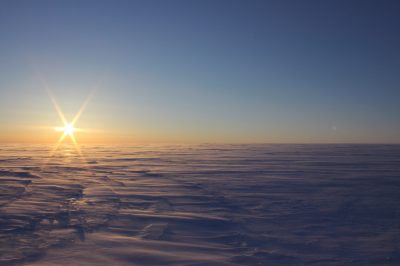Newly Discovered Salty Subglacial Lakes Could Help Search for Life in Solar System
December 3, 2018

Two newly discovered, subglacial lakes in the Canadian High Arctic could be a potential habitat for microbial life and may assist scientists in the search
for life beyond Earth, particularly on Jupiter’s icy moon Europa.
The findings, published April 11, 2018, in Science Advances, were made possible by airborne radar data acquired by the University of Texas Institute for Geophysics (UTIG) and NASA
“Geophysically characterizing these lakes and their sub-ice surroundings, followed by very careful sampling of their contents, should give us a real head start on understanding Europa’s potential for hosting life,” said co-author Donald Blankenship, a UTIG senior research scientist.
There are more than 400 known subglacial lakes in the world, concentrated primarily in Antarctica
with a few in Greenland, but these are the first found in the Canadian Arctic. Unlike all the others — which are thought to contain freshwater — these two appear to consist of extremely salty water. Their hypersalinity could make the lakes similar to those thought to be trapped inside the icy shell of Europa. In 2011, researchers from UTIG found evidence for such lakes on the Jovian moon.
An analysis of radar data shows that the lakes discovered in Canada are beneath 550 to 750 meters of ice under the Devon Ice Cap, one of the largest ice caps in the Canadian Arctic. They are thought to be the first isolated hypersaline subglacial lakes in the world, having no contact with an outside environment for thousands of years.
“If there is microbial life in these lakes, it has likely been under the ice for at least 120,000 years, so it likely
evolved in isolation,” said lead author Anja Rutishauser, a Ph.D. candidate at the University of Alberta who will join The University of Texas at Austin as a postdoctoral fellow when she finishes her degree.
By evaluating the airborne survey data and, eventually, samples from the lakes, scientists can better prepare for NASA’s forthcoming Europa Clipper mission, which is expected to deploy similar remote sensing techniques to
characterize Europa’s ice shell. For the Clipper mission, Blankenship is leading the development of the ice-penetrating radar sounder, an instrument similar to the one used to discover the Canadian lakes.
UTIG’s data acquisition and processing were supported by NASA’s Instrument Concepts for Europa Exploration Program, the G. Unger Vetlesen Foundation and the National Science Foundation.
Back to the Newsletter